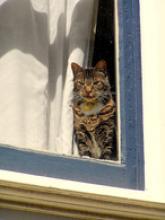As everyone knows, a cat always lands on its feet. (Not to mention the buttered cat paradox: if toast always lands butter side down, and cats always land on their feet, what happens if butter the top of a cat?) But the physics involved in this maneuver are truly impressive.
In order to right itself as quickly as possible, a falling cat relies on a fairly sophisticated use of physics. It twists its front half around to face the ground, and then its rear half.
But it doesn't do this the usual way; instead, the cat conserves the angular momentum created by its fall, by sticking out its back feet to create drag (so that the front can swing around more easily), then sticking out its front feet (to bring the rear around).
Obviously, cats paid a lot more attention in physics class than the rest of us.
Cats are tree hunters, ambush predators, which makes them prone to falling. And so you might expect that they would fall quite well. Darwinian evolution will quickly weed out the cats who fall poorly.
In fact, veterinarian clinics reported an interesting phenomenon which has been dubbed "High Rise Syndrome." In one summer in New York City, a vet clinic recorded an average of four cats falling from apartment windows a day. A veritable "rain of cats," as they pointed out on Stereolab.
Below five floors, cats survive falls. Above nine floors, cats survive falls. But there's a "danger zone" between the fifth and ninth floor, where the injuries sustained by the falls are most often fatal.
The hypothesis is that once the cat hits terminal velocity (the speed at which the cat will fall no faster) it relaxes, and its loose skin forms a sort of parachute to help increase the cat's drag and slow it down. In fact, a cat's terminal velocity is somewhere around 60MPH, which is often not fast enough to be fatal.
This parachute theory is called the "flying squirrel hypothesis." But as tempting as it is to imagine cats zooming and swooping around the city, there may be a more prosaic explanation.
When this topic came up among Ask Cecil fans in the late 1990s, they pointed out that these studies may be suffering from a fairly serious selection bias. Since the studies are conducted by veterinary offices, they reflect only the cats which are brought into the office. And no one brings their dead cat to the vet.
Therefore, the real number of falling cats is probably far greater than four per day. It's just that the cats who don't survive are mourned, but not taken to the vet. Unfortunately no more comprehensive survey of all falling cats has been undertaken to date. (I imagine the logistics of such a study would be difficult at best.)
In the mean time, as Cecil points out, it's not that ALL cats survive ALL high falls. It's that SOME cats survive SOME high falls. Please be sure to keep screens on your windows when they are open, and never leave a cat unattended on a balcony.
Photo credit: Flickr/Sean94112
